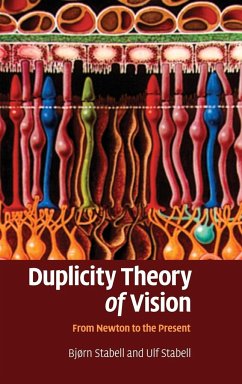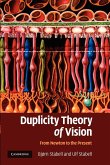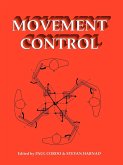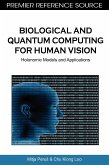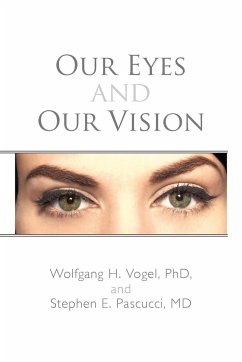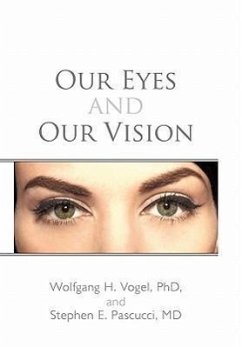- Gebundenes Buch
- Merkliste
- Auf die Merkliste
- Bewerten Bewerten
- Teilen
- Produkt teilen
- Produkterinnerung
- Produkterinnerung
This book chronicles the development of three classic theories within vision research, from the 17th century to today, focusing on duplicity theory.
Andere Kunden interessierten sich auch für
![Duplicity Theory of Vision Duplicity Theory of Vision]() Bj Rn StabellDuplicity Theory of Vision62,99 €
Bj Rn StabellDuplicity Theory of Vision62,99 €![Movement Control Movement Control]() J. Cordo / R. Harnad (eds.)Movement Control47,99 €
J. Cordo / R. Harnad (eds.)Movement Control47,99 €![Move Move]() Caroline WilliamsMove24,99 €
Caroline WilliamsMove24,99 €![Biological and Quantum Computing for Human Vision Biological and Quantum Computing for Human Vision]() Mitja Peru¿Biological and Quantum Computing for Human Vision266,99 €
Mitja Peru¿Biological and Quantum Computing for Human Vision266,99 €![Our Eyes and Our Vision Our Eyes and Our Vision]() Wolfgang H. VogelOur Eyes and Our Vision17,99 €
Wolfgang H. VogelOur Eyes and Our Vision17,99 €![Staging Neuropsychiatric Disorders Staging Neuropsychiatric Disorders]() Staging Neuropsychiatric Disorders122,99 €
Staging Neuropsychiatric Disorders122,99 €![Our Eyes and Our Vision Our Eyes and Our Vision]() Wolfgang H VogelOur Eyes and Our Vision25,99 €
Wolfgang H VogelOur Eyes and Our Vision25,99 €-
-
-
This book chronicles the development of three classic theories within vision research, from the 17th century to today, focusing on duplicity theory.
Hinweis: Dieser Artikel kann nur an eine deutsche Lieferadresse ausgeliefert werden.
Hinweis: Dieser Artikel kann nur an eine deutsche Lieferadresse ausgeliefert werden.
Produktdetails
- Produktdetails
- Verlag: Cambridge University Press
- Seitenzahl: 238
- Erscheinungstermin: 27. September 2016
- Englisch
- Abmessung: 235mm x 157mm x 17mm
- Gewicht: 501g
- ISBN-13: 9780521111171
- ISBN-10: 052111117X
- Artikelnr.: 26526631
- Herstellerkennzeichnung
- Libri GmbH
- Europaallee 1
- 36244 Bad Hersfeld
- gpsr@libri.de
- Verlag: Cambridge University Press
- Seitenzahl: 238
- Erscheinungstermin: 27. September 2016
- Englisch
- Abmessung: 235mm x 157mm x 17mm
- Gewicht: 501g
- ISBN-13: 9780521111171
- ISBN-10: 052111117X
- Artikelnr.: 26526631
- Herstellerkennzeichnung
- Libri GmbH
- Europaallee 1
- 36244 Bad Hersfeld
- gpsr@libri.de
1. Introduction
Part I. The Development of the Basic Ideas of the Duplicity Theory from Newton to G. E. Müller: 2. The Newton tradition
3. The Schultze tradition
4. The Goethe tradition. The phenomenological approach
5. The colour theories of Armin Tschermak and George Elias Müller
Part II. The Development of the Duplicity Theory from 1930-66: 6. The duplicity theory of Polyak
7. Investigations of H. K. Hartline and S. W. Kuffler
8. The duplicity theory of R. Granit
9. Contributions of E. N. Willmer, P. Saugstad & A. Saugstad, and I. Lie
10. Status of the duplicity theory in the mid 1960s and its further development
Part III. Chromatic Rod Vision: An Historical Account: 11. Night vision may appear bluish
12. Mechanisms of chromatic rod vision in scotopic illumination
13. Rod-cone interactions in mesopic vision
14. Contribution of J. J. McCann and J. L. Benton
15. Contribution of P. W. Trezona
16. Contribution of C. F. Stromeyer III
17. Contribution of Steven Buck and co-workers
18. Contribution of J. L. Nerger and co-workers
Part IV. Theories of Sensitivity Regulation of the Rod and Cone Systems: A Historical Account: 19. Introduction
20. Early photochemical explanations
21. Contribution of S. Hecht
22. Contribution of G. Wald. Photochemical sensitivity regulation of rods and cones
23. Relationship between amount of rhodopsin and sensitivity during dark adaptation
24. Post-receptor sensitivity regulation mechanisms
25. Rushton's A.G.C. model. Each receptor type has a separate and independent adaptation pool
26. Are light and dark adaptation really equivalent?
27. A decisive experiment
28. The adaptation mechanisms explored by the after-flash technique
29. Limitations of Rushton's photochemical theory
30. Contribution of H. B. Barlow
31. Rushton and Barlow compared
32. Contribution of T. D. Lamb
33. The Dowling-Rushton equation refuted
34. Difference between rod and cone dark adaptation
35. Light and dark adaptation are not equivalent
36. Allosteric regulation of dark adaptation
37. A search for the allosteric adaptation mechanisms
38. Several mechanisms involved in sensitivity regulation
39. Sensitivity regulation due to rod-cone interaction
40. Modern conceptions of sensitivity regulation
Part V. Factors that Triggered the Paradigm Shifts in the Development of the Duplicity Theory: 41. Summary of K. R. Popper's and T. S. Kuhn's models of scientific development
42. The development of the duplicity theory as a test of Popper's and Kuhn's models
43. References.
Part I. The Development of the Basic Ideas of the Duplicity Theory from Newton to G. E. Müller: 2. The Newton tradition
3. The Schultze tradition
4. The Goethe tradition. The phenomenological approach
5. The colour theories of Armin Tschermak and George Elias Müller
Part II. The Development of the Duplicity Theory from 1930-66: 6. The duplicity theory of Polyak
7. Investigations of H. K. Hartline and S. W. Kuffler
8. The duplicity theory of R. Granit
9. Contributions of E. N. Willmer, P. Saugstad & A. Saugstad, and I. Lie
10. Status of the duplicity theory in the mid 1960s and its further development
Part III. Chromatic Rod Vision: An Historical Account: 11. Night vision may appear bluish
12. Mechanisms of chromatic rod vision in scotopic illumination
13. Rod-cone interactions in mesopic vision
14. Contribution of J. J. McCann and J. L. Benton
15. Contribution of P. W. Trezona
16. Contribution of C. F. Stromeyer III
17. Contribution of Steven Buck and co-workers
18. Contribution of J. L. Nerger and co-workers
Part IV. Theories of Sensitivity Regulation of the Rod and Cone Systems: A Historical Account: 19. Introduction
20. Early photochemical explanations
21. Contribution of S. Hecht
22. Contribution of G. Wald. Photochemical sensitivity regulation of rods and cones
23. Relationship between amount of rhodopsin and sensitivity during dark adaptation
24. Post-receptor sensitivity regulation mechanisms
25. Rushton's A.G.C. model. Each receptor type has a separate and independent adaptation pool
26. Are light and dark adaptation really equivalent?
27. A decisive experiment
28. The adaptation mechanisms explored by the after-flash technique
29. Limitations of Rushton's photochemical theory
30. Contribution of H. B. Barlow
31. Rushton and Barlow compared
32. Contribution of T. D. Lamb
33. The Dowling-Rushton equation refuted
34. Difference between rod and cone dark adaptation
35. Light and dark adaptation are not equivalent
36. Allosteric regulation of dark adaptation
37. A search for the allosteric adaptation mechanisms
38. Several mechanisms involved in sensitivity regulation
39. Sensitivity regulation due to rod-cone interaction
40. Modern conceptions of sensitivity regulation
Part V. Factors that Triggered the Paradigm Shifts in the Development of the Duplicity Theory: 41. Summary of K. R. Popper's and T. S. Kuhn's models of scientific development
42. The development of the duplicity theory as a test of Popper's and Kuhn's models
43. References.
1. Introduction
Part I. The Development of the Basic Ideas of the Duplicity Theory from Newton to G. E. Müller: 2. The Newton tradition
3. The Schultze tradition
4. The Goethe tradition. The phenomenological approach
5. The colour theories of Armin Tschermak and George Elias Müller
Part II. The Development of the Duplicity Theory from 1930-66: 6. The duplicity theory of Polyak
7. Investigations of H. K. Hartline and S. W. Kuffler
8. The duplicity theory of R. Granit
9. Contributions of E. N. Willmer, P. Saugstad & A. Saugstad, and I. Lie
10. Status of the duplicity theory in the mid 1960s and its further development
Part III. Chromatic Rod Vision: An Historical Account: 11. Night vision may appear bluish
12. Mechanisms of chromatic rod vision in scotopic illumination
13. Rod-cone interactions in mesopic vision
14. Contribution of J. J. McCann and J. L. Benton
15. Contribution of P. W. Trezona
16. Contribution of C. F. Stromeyer III
17. Contribution of Steven Buck and co-workers
18. Contribution of J. L. Nerger and co-workers
Part IV. Theories of Sensitivity Regulation of the Rod and Cone Systems: A Historical Account: 19. Introduction
20. Early photochemical explanations
21. Contribution of S. Hecht
22. Contribution of G. Wald. Photochemical sensitivity regulation of rods and cones
23. Relationship between amount of rhodopsin and sensitivity during dark adaptation
24. Post-receptor sensitivity regulation mechanisms
25. Rushton's A.G.C. model. Each receptor type has a separate and independent adaptation pool
26. Are light and dark adaptation really equivalent?
27. A decisive experiment
28. The adaptation mechanisms explored by the after-flash technique
29. Limitations of Rushton's photochemical theory
30. Contribution of H. B. Barlow
31. Rushton and Barlow compared
32. Contribution of T. D. Lamb
33. The Dowling-Rushton equation refuted
34. Difference between rod and cone dark adaptation
35. Light and dark adaptation are not equivalent
36. Allosteric regulation of dark adaptation
37. A search for the allosteric adaptation mechanisms
38. Several mechanisms involved in sensitivity regulation
39. Sensitivity regulation due to rod-cone interaction
40. Modern conceptions of sensitivity regulation
Part V. Factors that Triggered the Paradigm Shifts in the Development of the Duplicity Theory: 41. Summary of K. R. Popper's and T. S. Kuhn's models of scientific development
42. The development of the duplicity theory as a test of Popper's and Kuhn's models
43. References.
Part I. The Development of the Basic Ideas of the Duplicity Theory from Newton to G. E. Müller: 2. The Newton tradition
3. The Schultze tradition
4. The Goethe tradition. The phenomenological approach
5. The colour theories of Armin Tschermak and George Elias Müller
Part II. The Development of the Duplicity Theory from 1930-66: 6. The duplicity theory of Polyak
7. Investigations of H. K. Hartline and S. W. Kuffler
8. The duplicity theory of R. Granit
9. Contributions of E. N. Willmer, P. Saugstad & A. Saugstad, and I. Lie
10. Status of the duplicity theory in the mid 1960s and its further development
Part III. Chromatic Rod Vision: An Historical Account: 11. Night vision may appear bluish
12. Mechanisms of chromatic rod vision in scotopic illumination
13. Rod-cone interactions in mesopic vision
14. Contribution of J. J. McCann and J. L. Benton
15. Contribution of P. W. Trezona
16. Contribution of C. F. Stromeyer III
17. Contribution of Steven Buck and co-workers
18. Contribution of J. L. Nerger and co-workers
Part IV. Theories of Sensitivity Regulation of the Rod and Cone Systems: A Historical Account: 19. Introduction
20. Early photochemical explanations
21. Contribution of S. Hecht
22. Contribution of G. Wald. Photochemical sensitivity regulation of rods and cones
23. Relationship between amount of rhodopsin and sensitivity during dark adaptation
24. Post-receptor sensitivity regulation mechanisms
25. Rushton's A.G.C. model. Each receptor type has a separate and independent adaptation pool
26. Are light and dark adaptation really equivalent?
27. A decisive experiment
28. The adaptation mechanisms explored by the after-flash technique
29. Limitations of Rushton's photochemical theory
30. Contribution of H. B. Barlow
31. Rushton and Barlow compared
32. Contribution of T. D. Lamb
33. The Dowling-Rushton equation refuted
34. Difference between rod and cone dark adaptation
35. Light and dark adaptation are not equivalent
36. Allosteric regulation of dark adaptation
37. A search for the allosteric adaptation mechanisms
38. Several mechanisms involved in sensitivity regulation
39. Sensitivity regulation due to rod-cone interaction
40. Modern conceptions of sensitivity regulation
Part V. Factors that Triggered the Paradigm Shifts in the Development of the Duplicity Theory: 41. Summary of K. R. Popper's and T. S. Kuhn's models of scientific development
42. The development of the duplicity theory as a test of Popper's and Kuhn's models
43. References.

